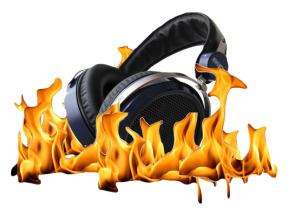Many high end audiophile products such as amplifiers, speakers, headphones and even connection cords and power conditioners are sold with the advice that they will produce better sound when they are used. Many manufacturers recommend burn in for audio components before the full benefit will be realized. For someone who has always been skeptical that new things actually improve with wear, the concept of giving a product “burn in” time was worth a test.

In April I bought the new Meridian Explorer DAC and I selected the HiFiMan HE500 headphones and EF5 headphone amplifier. I bought all three around the same time so I could enjoy the high definition downloads from HDtracks in the early morning hours and at times when family members are around.
The manufacturers of these products recommend “burn in.” Meridian suggests 300 hours for the Explorer and instructions that come with the HiFiMan EF5 amplifier suggest 150 hours of “continuous use” to burn in the tube. Headphone and speaker burn in times vary between 75 hours and 500 hours depending on who you consult.
Armed with my skepticism, I set up my micro environment by attaching the Meridian Explorer to the EF5 and then connecting my HE500 cams to it. I went to HDtracks and downloaded the JRiver Media Center and Amber Rubarth’s, Sessions from the 17th Ward on the Chesky record label. It is available on HDtracks in 192 kHz/24 bit and it makes an excellent reference recording for sound experiments like this. It is also an outstanding album with unbelievably brilliant mastering and production.
It is easy to let components run when you use headphones. While you can hear the music playing faintly in the background at night, it isn’t very bothersome to people. The harder part of the experiment was selecting a long stretch of time that I did not need my laptop. 150 continuous hours translates into 6 days where my laptop had to be in the same location. Again, headphones make long stretches of time like this possible.
With all of that great music playing on my laptop I certainly could not resist taking an occasional listen. From time to time I would go back to my reference recording and see if it sounded “better” than the first time I heard it. Each time I listened in I could not truthfully say I noticed a difference. By the third or fourth day I was tempted to stop the experiment because I thought the inconvenience of not having my laptop was not worth it.
By the fourth or fifth day, I was bored with the experiment and didn’t even bother to listen in. After six days, I very anxiously stopped the music and shut down my laptop. At that point I was more concerned with overheating than with better sound from my components.
It took me at least a day or two to catch up with the other work I needed to do with my laptop that I could not otherwise handle through my iPad. In the meantime I had unplugged the Meridian Explorer and shut down the HF5 HiFiMan amplifier.
When I had time to pay attention to music again over the weekend, I reconnected everything to my laptop and launched my Amber Rubarth recording on JRiver. It was unbelievable. The notes had more depth and fullness. The midrange was more pronounced. The overall sound had more space and the acoustic detail was absolutely enhanced from when I heard this recording on this same equipment the first time.
At first I thought that I was just appreciating the genius of David Chesky’s audio recording and mastering and the richness of Amber Rubarth’s voice. So I tried other pieces of music that I know. Pink Floyd’s, Dark Side of the Moon was a new listening experience. Even the Kink’s, Village Green Preservation Society had more detail and a richer sound stage than I had remembered before and during the first hours of the burn in when I listened.
There is now no question in my mind that new high end audio components need to be used before you can really appreciate their full potential. What is not clear from a science point of view is which of the three components I tested benefited most from the 150 hour continuous burn in because I didn’t test them separately. However sound quality is very subjective and a matter of individual taste so it is impossible to really quantify other than to notice when something is good and when something is better.
